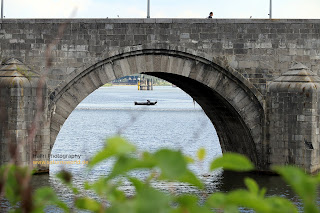
One of the most remarkable views (next to the big church) is the St Servaas Brug

The Sint Servaasbrug (or the St. Servatius Bridge) is an arched stone footbridge across the Meuse River in Maastricht, Netherlands. It is named after Saint Servatius, the first bishop of Maastricht, and (despite being largely rebuilt after World War II) it has been called the oldest bridge in the Netherlands.
The Romans built a wooden bridge across the Meuse in what is now Maastricht, in approximately AD 50, and the Latin phrase for "crossing of the Meuse", "mosae trajectum", became the name of the city. For many years this remained the only crossing of the lower Meuse. However, the Roman bridge collapsed in the year 1275 from the weight of a large procession, killing 400 people.Its replacement, the present bridge, was built somewhat to the north of the older crossing between 1280 and 1298; The Roman Catholic Church encouraged its construction by providing indulgences to people who helped build it. The bridge was accoladed in honor of Saint Servatius this time.
The bridge was renovated in 1680, and in 1825 a wooden strutwork section on the east side of the bridge was replaced by a stone arch. In 1850, as part of the construction of the Maastricht-Liège Canal, a channel was cut on the west side of the bridge.
When in the early 1930s the bridge had been relieved of its function as the city's only river crossing by the construction of the Wilhelmina bridge, 300 metres (1,000 ft) downstream, a major renovation was performed. The arches were reconstructed in concrete, covered with the original stones. Underwater, counter-arches were constructed to prevent erosion of the river bed on which the bridge was built. Two arches on the eastern end of the bridge were removed and replaced by a vertical-lift bridge. Between the two bridges, on the eastern side of the river, a levee was built to separate the navigable eastern channel from the rest of the river.
During World War II the bridge was severely damaged by the German army as they retreated from the Netherlands in 1944, but it was rebuilt in 1948. In 1962, the shipping channel to the east of the bridge was spanned by a steel drawbridge attached to the main bridge


